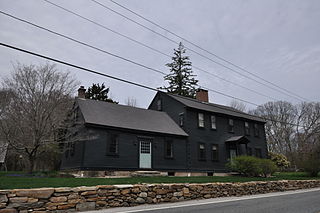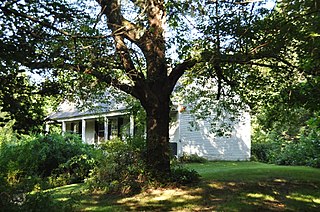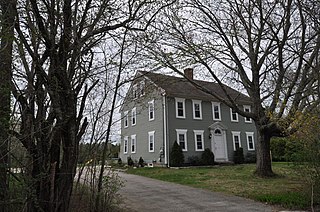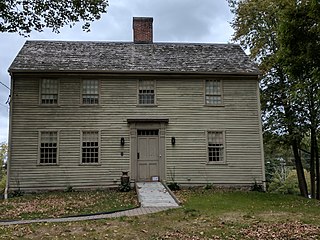
The Clemence–Irons House is a historic house at 38 George Waterman Road in Johnston, Rhode Island. It was built by Richard Clemence in 1691 and is a rare surviving example of a "stone ender", a building type first developed in the western part of England and common in colonial Rhode Island. The house is listed on the National Register of Historic Places, and is a historic house museum owned and operated by Historic New England. It is open Saturdays between June and mid-October.

The Governor Stephen Hopkins House is a museum and National Historic Landmark at 15 Hopkins Street in Providence, Rhode Island. The house was the home of Stephen Hopkins, a governor of Rhode Island and signatory of the Declaration of Independence.

The Joseph Reynolds House is a historic house at 956 Hope Street in Bristol, Rhode Island, built c. 1698–1700. The three-story wood-frame house is one of the oldest buildings in Bristol and the oldest known three-story building in Rhode Island. It exhibits distinctive, well-preserved First Period features not found in other houses, despite an extensive history of adaptive alterations. It is further significant for its use by the Marquis de Lafayette as headquarters during the American Revolutionary War. It was designated a National Historic Landmark in 1983.

The William Mowry House is an historic farm house on Farnum Pike in North Smithfield, Rhode Island. It is a 2-1/2 story plank-framed house, five bays wide, with a gable roof and a large central chimney. The main entrance is centered on the main (south-facing) entry, and is enclosed within a single-story hip-roof vestibule of 20th-century construction. A small single-story ell extends to the west of the main block. The interior follows a typical center-chimney plan, with the kitchen and parlor in the front of the house, and the dining room flanked by a small pantry and bathroom in the rear. The house was built c. 1802-05 by William Mowry, whose family has owned land in the area since the 17th century.

The Ballou House is an historic house on Albion Road in Lincoln, Rhode Island. It is a 2-1/2 story wood frame structure, five bays wide, with a large central chimney. A single-story gable-roof wing extends to the east, and a 20th-century gambrel-roofed ell extends to the north. The house was probably built c. 1782 by Moses Ballou, from one of the first families to settle in the area, and was owned by his descendants through most of the 19th century.

The Battey–Barden House is an historic house at 710 Plainfield Pike in Scituate, Rhode Island, US. It is a 2 1⁄2-story wood-frame structure with a large central chimney. A 1 1⁄2-story kitchen ell extends from the rear of the main block. The main block's construction date is uncertain, with architectural evidence suggesting it was built between about 1816 and 1831. It was probably built around 1824 for Horace Battey, a farmer and shopkeeper. The house is particularly notable for the stencilwork on its interior walls.

The Captain George Dorrance House is an historic house at 2 Jencks Road in Foster, Rhode Island. It is located on the west side of the road, a short way south of its junctions with Plain Woods Road, not far from the Connecticut border. It is a 2-1/2 story wood frame structure, five bays wide, with a gable roof and a large central chimney. The main block was built c. 1720, and a leanto was added c. 1750. It is one of the best-preserved early 18th-century houses in the state.

The Mount Vernon Tavern, also known as the Bank House Tavern, is an historic house in Foster, Rhode Island. It is located at 199 Plainfield Pike, about 3/10 of a mile east of its junction with Howard Hill Road. The main block of the house, a 2-1/2 story wood frame structure with gable roof, was built c. 1760, and was originally attached to an even older structure which was demolished in the late 19th century. This main block, five bays wide with a central chimney, is attached to a 1-1/2 story gable-roofed ell to the west. The main entrance portico features unusually elaborate Federal styling for a rural location, and was probably added in 1814. The house has long been a landmark on the road, serving as a stagecoach stop on what was the main road between Providence and points in Connecticut.

The Lewis Tower House is an historic house at 2199 Mendon Road in Cumberland, Rhode Island.

The Stephen Allen House is an historic house on Sharp Street, on the northeast corner of its junction with Rhode Island Route 102, in West Greenwich, Rhode Island. The main block of this 1-1/2 story Cape style wood frame house was built c. 1787 by Stephen Allen, a farmer. The house is five bays wide, with a central chimney and a center entry which is framed by a later Greek Revival surround. There is a 1-1/2 story ell extending to the east (right) of the main block. To the east of the main house stands what originally appeared to be a shed that has since been converted for use as a small horse stable. Evidence suggests this structure was built sometime before 1862 as a store.

The Peleg Champlin House is an historic house on Rodman Pond Lane in western New Shoreham, on Block Island, in Rhode Island. It is a 1-1/2 story wood frame structure, five bays wide, with a side-gable roof and a large central chimney. An ell extends from the back (north) side of the house. The Federal style wooden house was built c. 1820 by Peleg Champlin, a farmer from one of the island's older families. The house is one of the best-preserved houses of the period on the island.

The R.R. Gardner House is a historic house located at 700 Curtis Corner Road in South Kingstown, Rhode Island.

The Joseph Jeffrey House is an historic house on Old Mill Road in Charlestown, Rhode Island. It is located on the east side of Old Mill Road, just south of Saw Mill Pond and Sawmill Brook, on a predominantly wooded 9.5-acre (3.8 ha) lot. The main house is a 1-1/2 story wood frame structure with a gambrel roof and central chimney, with a small gable-roof ell to the northeast. The oldest portion of the main block appears to be the easterly side, which rests on an old stone foundation, and exhibits construction methods typical of the second quarter of the 18th century. The house was probably built by Joseph Jeffrey, a Narragansett, on land granted to him by the tribe, whose advisory council he sat on.

The Joseph Briggs House, also known as the Coventry Town Farm, is an historic house at 195 Town Farm Road in Coventry, Rhode Island. The main block of the house, a 2-1/2 story wood frame structure, was built c. 1790 by Joseph Briggs, and the property was purchased from his heirs in 1851 by the town for use as a poor farm. The town added a two-story ell to the rear of the house to provide additional housing space. The property is one of the few such poor farms to remain relatively intact. The farm was closed in the 1930s, after which the property fell into decline. It has since been rehabilitated as a two-family residence.

The Charles Payne House is an historic site at 25 Brown Street in Pawtucket, Rhode Island. The house was built in 1855–56 by Charles Payne and later expanded with the addition of two ells and a porch. The 1 1⁄2-story Gothic-Italianate vernacular cottage is architecturally significant as a 19th-century vernacular cottage in a picturesque setting. Though the round-head picket fence and entry gates were later removed, the property retains a large shaded garden on with ample street frontage. The Charles Payne House was added to the National Register of Historic Places in 1983.

The Captain Goodwin–James Eustis House is a historic house located at 1 Elm Street in Wakefield, Massachusetts. Built about 1760 and enlarged around 1830, it is a good local example of Greek Revival architecture, which was owned by a prominent local businessman and civic leader. The house was listed on the National Register of Historic Places on March 2, 1990, where it is listed as the "Captain Goodwin–James Custis House".

The Andrew Clark House, also known as the Haskell House, is a historic house on Ross Hill Road in Lisbon, Connecticut. Built about 1798, it is a good example of transitional Georgian-Federal residential architecture. It was listed on the National Register of Historic Places on June 28, 1979.

The Esten–Bowen House is a historic house at 199 Iron Mine Road in Burrillville, Rhode Island. The 1 1/2 story timber frame Cape style house was built c. 1790 by John Esten, a major landowner in eastern Burrillville in the second half of the 18th century. The main block is five bays wide and two deep, with a massive central chimney. A kitchen ell to the right of the main block appears to be an early addition. The house was held in the Esten family until 1879, by which time its surrounding property had been reduced to just 30 acres (12 ha). This property was acquired by Esther Bowen in 1941 and the house was rehabilitated, with modest Colonial Revival alterations. The property includes a 19th-century shed, and foundational remnants of a blacksmithy and barn.

The John Moore House is a historic house on Cross Point Road in Edgecomb, Maine. With elements dating to the early 1740s, it is one of the oldest surviving structures in Mid Coast Maine. The connected farmstead includes a barn that was built before 1850. The property was listed on the National Register of Historic Places in 1979.

The David Sherman House is a historic house on Middle Quarter Road in Woodbury, Connecticut. Built about 1760, it is a well-preserved example of Colonial architecture. In 1781, David Sherman is reported to have hosted a ball for officers of the French Army of the Comte de Rochambeau during their march across Connecticut. The house was listed on the National Register of Historic Places in 2002.


























